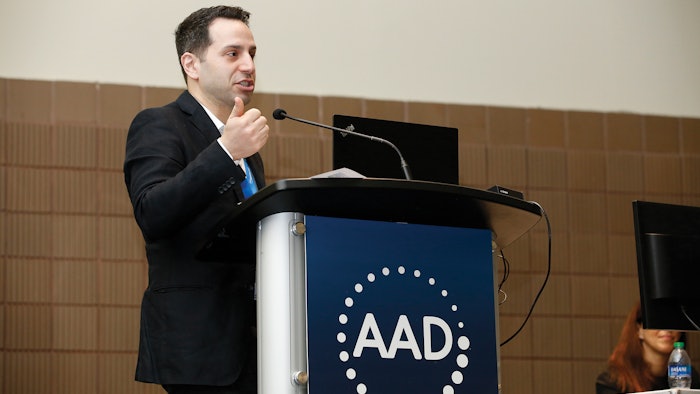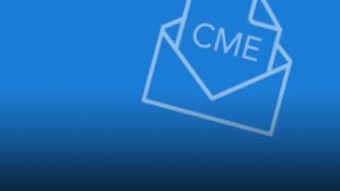The practical side of systemic treatment for adult atopic dermatitis
Late-onset AD is a reality.

Adults get atopic dermatitis less frequently than children but are often more difficult to treat than kids. Those easy-to-miss realities leave too many adults with atopic dermatitis undiagnosed and untreated. Even adults who are diagnosed are too often undertreated and suffering needlessly when dermatologists are slow to suggest escalating to systemic treatments. These issues were addressed during “U012 – Practical Considerations for Systemic Treatment of Atopic Dermatitis in Adults,” led by Aaron Mark Drucker, MD, FAAD, and including presentations by Katrina Abuabara, MD, FAAD, as well as Eric Lawrence Simpson, MD, MCR, FAAD.
What’s new?
New and different approaches are here. Dermatologists have long used methotrexate, cyclosporin, and azathioprine off label for atopic dermatitis, but clinical trial data are sparse, noted Dr. Drucker, a scientist at Women’s College Research Institute and associate professor of medicine at the University of Toronto Institute of Health Policy, Management, and Evaluation in Canada.
“In 2017, we began to get targeted systemic treatments, starting with dupilumab; then tralokinumab was approved. Now we have Janus kinase (JAK) inhibitors approved in the U.S. and Canada. The most important considerations are always how effective it is and how safe it is, along with cost and accessibility,” Dr. Drucker said.
Biologics and JAK inhibitors are both effective, Dr. Drucker said. At higher doses, JAK inhibitors are somewhat more effective than biologics, but also carry greater safety concerns.
“These agents are amazing for patients, and we’ve got more options that can, hopefully, improve patients’ lives with more on the way,” he said. “But more effective agents also make conversations with patients and decision making more complex. There are multiple factors to keep in mind, and we must make decisions with patients, not for them.”
It’s complicated
Dr. Abuabara, an associate professor of dermatology at the University of California, San Francisco, discussed some of the issues surrounding systemic treatment for adults. She asserted that treating adults with atopic dermatitis can be more complicated than treating children because adults have more conflicting considerations and demands on their time.
“Atopic dermatitis is quite common in adults,” Dr. Abuabara said. “The older studies that talked about most atopic dermatitis developing by age two weren’t necessarily wrong, but they were limited. If you only follow people to age seven, the majority get it by age two. When you extend the window of observation, you see higher and higher proportions of people with later and later onset of disease.”
Topicals are the first-line approach, but it can sometimes be difficult to convince an adult to apply cream or ointment to their skin consistently before work every day. Patients with disease on their face or hands may not be able to go to work, she said, while particularly itchy disease may impact sleep quality, which affects their quality of life.
“There are logistic factors with adults and topical treatments can be time-consuming and messy, which they won’t tolerate. Phototherapy can be effective and is very safe, but it requires going in two or three times a week, which can present work or transportation challenges and sometimes results in high co-pays. And there are patients who have tried topical steroids for years without success and want something new and different.”
 Left to right: Katrina Abuabara, MD, FAAD, and Eric Lawrence Simpson, MD, MCR, FAAD
Left to right: Katrina Abuabara, MD, FAAD, and Eric Lawrence Simpson, MD, MCR, FAAD
Lingering questions
The real question is whether the patient thinks their symptoms are under adequate control with the current therapy, said Dr. Simpson, professor of dermatology at Oregon Health and Science University School of Medicine in Portland. If the answer is ‘no,’ the disease is still bothersome, still has an impact on quality of life. It’s time to talk systemic treatment.
“Your responsibility is to care for your patient,” Dr. Simpson said. “And if they’re telling you that they are still suffering, despite what you think is an adequate topical or other treatment, they deserve the systemic treatment conversation.”
The biggest obstacle to appropriate use of systemics is therapeutic inertia, he said. Clinicians tend to continue using the same approaches they’ve used in the past.
“There is a real hesitancy to escalate treatment and patients suffer because of it,” Dr. Simpson said. “We need to recognize earlier the failure of topical therapy and the continued suffering that brings our patients. We need to offer treatment escalation earlier because, in general, adults with atopic dermatitis are undertreated.”











